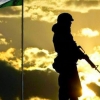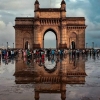
The crisp winter breeze wafted through the Kartavya Path as the dense morning fog gradually began to disperse, giving a slight respite to the bone-chilled yet enthusiastic Republic Day audience. The network of broadcasting cameras captured people zipping up their jackets upto the bottom of their ears or wrapping their mufflers in a death wrap over their necks and even heads. For Seikhohao Haokip, however, this was just another day in office. Seikhohao, nicknamed Seiko by his comrades due to his love of sports and chronographs (and mostly because they wanted a simpler way of addressing him), maintained a hawk eye on the surroundings as his SPG Counter Assault Team (CAT) formed the outer cordon of the Prime Minister’s security at Kartavya Path. Strutting the state of the art F2000TR bullpup rifles and EOtech 552 holographic weapon sights among a host of other weaponry and gadgetry, the CAT team made for an intimidating sight and attracted many a curious glance from the onlookers. French President Mr. Emanuel Macron was in attendance, and the SPG had spent months working with the French GSPR to ensure watertight security for their respective protectees. Seiko knew that the stakes, like always, were sky high.
As a part of the SPG, Seiko was acutely aware of his brief and felt privileged to be playing a role as the protector of his country’s supreme leader. Born and brought up in the quaint Manipuri hill town of Churachandpur, Seiko took pride in his Kuki-Zo roots and heritage. He studied at the local Don Bosco School and could be found singing Paite songs alongwith friends at the Café Eureka across the District Hospital on many an afternoon. But nature was his real love, and he would head into the hilly jungles surrounding the town whenever he could, trekking through the verdant expanses while marveling at the resplendent flora and fauna. He was a sharp young lad, and it appeared to be a pre-destined event when he joined the “Sentinels of the North East”, the Assam Rifles as an Assistant Commandant after his graduation. Fully embracing the legacy and credo of the Assam Rifles as a force that understood regional realities, Seiko built a reputation in the force as a tough-as-nails soldier who could neutralize an adversary, climb a steep hill and croon “Can’t buy me love” with equal ease. Seiko’s professional attributes and love for nature contributed in making him one of the distinguished officers in his batch to complete the jungle warfare course at the Counter-Insurgency and Jungle Warfare School at Vairengte. Deeply aware of the chequered history that the Assam Rifles have had during their years of deployment in the north east (the Thangjam Manorama tragedy being one of the pointed reminders of this), Seiko worked to sharpen his sensitivities to become a true peace keeper. In particular, he had grown up listening to stories and anecdotes relating to the simmering adversarial equation that the Meitei and Kuki-Zo had in his backyard, and thus understood the value of endearing peace in ensuring a livable future for the populace. Eventually, driven by an ambition to stretch his limits, Seiko volunteered to be considered for the elite Special Protection Group, and after a grueling selection procedure of interviews, background checks, physical tests and probation, he joined the Tactical unit of the SPG CAT.
The commencement of Seiko’s stint at the SPG almost coincided with the outbreak of unspeakable violence in Manipur after a questionable directive from the Manipur High Court that ordered the state government to recommend the Meitei as a Scheduled Tribe. This was of course breaking news only for the outside world. For Seiko and any other individual with working knowledge of the region, tribal dissonances have been like a perennially slow-boiling cauldron, with conflagration just a spark away. And like in any other scenario anywhere across the world, human fault lines have been utilized for nefarious political benefit. And true to the plot, the brunt of this diabolique has been borne by the exploited common populace. It did not help that the north east as a whole has been a faceless, shapeless, monolithic entity for the rest of the country. Mainland politics has actively worked to keep disinformation ripe, a recent case in point being the dissemination of the agenda that Bangladeshi immigrants (and not Indian Bengalis) were the major source of discontent for ethnic Ahomiya people. The extent and ferocity of the Manipuri violence, thus, took many by surprise.
The inexplicable state of denial that the central and state governments chose to remain in while rampaging opposing mobs plundered, murdered and raped made things worse in Manipur than they actually were. While the political sycophants and servile media chose to ignore what was happening on the ground, the government made further tactical mistakes. Deployment of central forces in Manipur who did not have a pragmatic understanding of the complicated local dynamics let to more state atrocities which further exacerbated the tragedy. Indeed, as Gen. Jack D. Ripper remarked in Kubrick’s amazing Dr. Strangelove, “War is too important to be left to politicians. They have neither the time, the training nor the inclination for strategic thought.”
Seiko’s deployment meant that he was far away geographically from these riots, but his colleagues at Assam Rifles, his family and friends kept him abreast of the terrible human tragedy that was engulfing the state. At a personal level, Seiko was acutely disturbed by the ongoings back home and the way politicians were dragging the state into further anarchy and destruction. On Kartavya Path that day, as the Prime Minister addressed the nation and celebrated the various achievements of the Indian government over the past year and beyond, a part of Seiko’s mind lamented the conspicuous absence of will on the part of the apex leadership to address or atleast acknowledge several issues plaguing the country – poverty, unemployment, religious othering, corruption, unchecked dog-whistling, policy apathy to name a few. Worse still, the government appeared to be even providing a tailwind to these maladies. In such a milieu, his protectee’s speeches appeared to be completely in conflict with reality on many occasions.
Seiko was also painfully aware of another reality, one that affected him personally to a greater extent. During one of his evening runs through the SPG Complex at New Delhi when his unit was off-duty, he had overheard a conversation amongst a group of civilians. They spoke of the precursors of the SPG’s founding and how a leader’s policy failures had led to her assassination by her personal bodyguards. Unaware of Seiko’s presence nearby, they wondered if having Manipuri bodyguards on the SPG detail in the present scenario was the right strategy. Seiko knew this wasn’t an isolated case. These guys know their gossip, Seiko had chuckled, but they definitely don’t know the SPG. The bedrock of the SPG is embodied by its credo of Śauryam Samarpaṇam Surakṣaṇam or Bravery, Dedication, Security. Personal emotions and opinions do not deter an SPG protector from discharging his/ her duty, and his/ her duty unto death is to ensure the safety of the protectee.
Seiko’s eyes twinkled behind his eyegear as he rekindled the pride of being part of the SPG. Across the street, the prime ministerial motorcade had departed the Kartavya Path, and it was time for the CAT to stand down.
About the Author






Comments